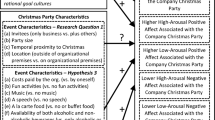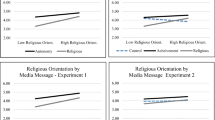Abstract
Workplace religious expression has become an intensely debated topic across news outlets and social media. However research on what constitutes acceptable vs unacceptable workplace religious display is sparse. At a time when EEOC claims involving religion are on the rise there is a clear need for study in this area. In this study participants in two samples read 27 scenarios where an interviewer engaged in a Christian religious display during a job interview. We used Christian religious displays for their ease of recognition in an American sample. Participants rated each workplace religious display in terms of likelihood of occurrence and organization attractiveness. In both samples organization attractiveness ratings were more negative than expected in a predominantly Christian sample signifying that while individuals may value their ability to express their religion they may not appreciate such displays from those who represent an organization. Verbal and physical religious displays received more negative ratings compared to scenarios that spoke to shared experiences such as displaying pictures of one’s children in a religious ceremony. Application in organizations and HR implications are discussed.

Similar content being viewed by others
References
Alidadi, K. (2010). Religion and the workplace. RELIGARE - religious diversity and secular models in Europe innovative approaches to law and policy. Retrieved from http://www.religareproject.eu/system/files/WP4_State_of_the_art_Religion_%2526_the_Workplace_e-version_0.pdf
Ashmos, D. P., & Duchon, D. (2000). Spirituality at work. Journal of Management Inquiry, 9(2), 134–145.
Atkinson, W. (2004). Religion in the workplace: faith versus liability. Risk Management, 15(12), 18–23.
Ball, C., & Haque, A. (2003). Diversity in religious practice: implications of Islamic values in the public workplace. Public Personnel Management, 32(3), 315–330.
Benefiel, M., Fry, L. W., & Giegle, D. (2014). Spirituality and religion in the workplace: history, theory, and research. Psychology of Religion and Spirituality, 6(3), 175–187.
Berg, T. C. (1998). Religious speech in the workplace: harassment or protected speech. Harvard Journal of Law & Public Policy, 22, 959.
Blogowska, J., & Saroglou, V. (2011). Religious fundamentalism and limited prosociality as a function of target. Journal for the Scientific Study of Religion, 50(1), 44–60.
Borstorff, P. (2011). Protecting religion in the workplace? What employees think. Journal of Legal, Ethical and Regulatory Issues, 14(1), 59–70.
Byron, K., & Lawrence, G. A. (2015). Diplomas, photos and tchotchkes as symbolic self-representations: understanding employees’ individual use of symbols. Academy of Management Review, 58(1), 298–323.
Cash, C., & Gray, G. (2000). A framework for accommodating religion and spirituality in the workplace. Academy of Management Executive, 14(3), 124–133.
Charita D Chalmers v. Tulon Company of Richmond. (1996). No. 95–2594, 101 F.3d 1012 (United States District Court for the Eastern District of Virginia, at Richmond).
Cromwell, J. B. (1997). Cultural discrimination: the reasonable accommodation of religion in the workplace. Employee Responsibilities and Rights Journal, 10(2), 155–172.
de Vogue, A. (2014). Hobby Lobby wins contraceptive ruling in Supreme Court. Retrieved August 25, 2014 from http://abcnews.go.com/Politics/hobby-lobby-wins-contraceptive-ruling-supreme-court/story?id=24364311.
de Vries, M. F. K., & Miller, D. (1986). Personality, culture, and organization. Academy of Management Review, 11(2), 266–279.
Dean, K. L., Safranski, S. R., & Lee, E. S. (2014). Religious accommodation in the workplace: understanding religious identity threat and workplace behaviors in legal disputes. Employee Responsibilities and Rights Journal, 26(2), 75–94.
Dockterman, E. (2014). 5 things women need to know about the Hobby Lobby ruling. Retrieved August, 25, 2014 from http://time.com/2941323/supreme-court-contraception-ruling-hobby-lobby/.
Fernando, M., & Jackson, B. (2006). The influence of religion-based workplace spirituality on business leaders’ decision-making: an inter-faith study. Journal of Management & Organization, 12(1), 23–39.
Frégosi, F., & Kosulu, D. (2013). Religion and religious discrimination in the French workplace increasing tensions, heated debates, perceptions of labour unionists and pragmatic best practices. International Journal of Discrimination and the Law, 13(2–3), 194–213.
Gallup Inc. (2013). Religion .Retrieved March 19, 2015 from http://www.gallup.com/poll/1690/religion.aspx
Gallup Inc. (2015). The “40-Hour” Work Week is Actually Longer – by Seven Hours. .Retrieved from http://www.gallup.com/poll/175286/hour-workweek-actually-longer-seven-hours.aspx
Gebert, D., Boerner, S., Kearney, E., King Jr., J. E., Zhang, K., & Song, L. J. (2014). Expressing religious identities in the workplace: analyzing a neglected diversity dimension. Human Relations, 67(5), 543–563.
Ghumman, S., & Jackson (2008). Between a cross and hard place: religious identifiers and employability. Journal of Workplace Rights, 13(3), 259–279. doi:10.2190/WR.13.3.d.
Ghumman, S., Ryan, A. M., Barclay, L. A., & Markel, K. S. (2013). Religious discrimination in the workplace: a review and examination of current and future trends. Journal of Business and Psychology, 28(4), 439–454.
Gregory, R. (2011). Encountering religion in the workplace: the legal rights and responsibilities of employers. London: Cornell University Press.
Harrington, W. J., Preziosi, R. C., & Gooden, D. J. (2001). Perceptions of workplace spirituality among professionals and executives. Employee Responsibilities and Rights Journal, 13(3), 155–163.
Harris, M. M., & Fink, L. S. (1987). A field study of employment opportunities: does the recruiter make a difference? Personnel Psychology, 40(4), 765–784.
Hicks, D. (2003). Religion and the work place – pluralism, spirituality, leadership. Cambridge: Cambridge University Press.
Hill, P., Pargament, K., Wood, R., Mccullough, M., Swayers, J., Larson, D., & Zinnbauer, B. (2000). Conceptualizing religion and spirituality: points of commonality, points of departure. Journal for the Theory of Social Behaviour, 30(1), 51–77.
Hunsberger, B., & Jackson, L. M. (2005). Religion, meaning, and prejudice. Journal of Social Issues, 61(4), 807–826.
Jeltsen, M. (2012). Chick-Fil-A has ‘record-setting day’ while embroiled in anti-gay controversy. Retrieved August 25, 2014 from http://www.huffingtonpost.com/2012/08/02/chick-fil-a-has-record-setting-day-anti-gay_n_1733697.html.
King Jr, J. E., & Holmes, I. O. (2012). Spirituality, recruiting, and total wellness: overcoming challenges to organizational attraction. Journal of Management, Spirituality & Religion, 9(3), 237–253. doi:10.1080/14766086.2012.728881.
King, J. E., Avery, D. R., & Sackett, P. (2013). Editorial: three perspectives of employment discrimination 50 Years after the civil rights act – a promise fulfilled? Journal of Business and Psychology, 28(4), 375–382. doi:10.1007/s10869-013-9323-8.
Legislation.gov.uk. (2015). Equality Act 2010. Retrieved April 20, 2015 from http://www.legislation.gov.uk/ukpga/2010/15.
Lips-Wiersma, M., & Mills, C. (2002). Coming out of the closet: negotiating spiritual expression in the workplace. Journal of Managerial Psychology, 17(3), 183–202.
Markoe, L. (2013). Hobby Lobby boycotts Jewish Hanukkah and Passover (UPDATE) Retrieved August 25, 2014 from http://www.huffingtonpost.com/2013/10/02/hobby-lobby-jewish-boycott-steve-green_n_4032295.html.
Martinez, M. (2015). Who is Kim Davis. Kentucky clerk jailed over same-sex marriage licenses? Retrieved April 10, 2016 from http://www.cnn.com/2015/09/04/us/kim-davis-things-to-know.
Milliman, J., Czaplewski, A. J., & Ferguson, J. (2003). Workplace spirituality and employee work attitudes: an exploratory empirical assessment. Journal of Organizational Change Management, 16(4), 426–447.
Mitroff, I. I., & Denton, E. A. (1999). A study of spirituality in the work place. Sloan Management Review, 40(4), 83–92.
O’Reilly, C. A., Caldwell, D. F., Chatman, J. A., & Doerr, B. (2014). The promise and problems of organizational culture CEO personality, culture, and firm performance. Group & Organization Management, 39(6), 595–625.
Paterson, T. A., Specht, D., & Duchon, D. (2013). Exploring costs and consequences of religious expression in family businesses. Journal of Management, Spirituality & Religion, 10(2), 138–158.
Petriglieri, J. L. (2011). Under threat: responses to and the consequences of threats to individual identities. Academy of Management Review, 36(4), 641–662.
Pew Research Center. (2008). U.S. religious landscape survey. Retrieved March 23, 2015 from http://religions.pewforum.org/pdf/report-religious-landscape-study-full.pdf.
Pew Research Center. (2015). Millennials surpass Gen Xers as the largest generation in U.S. labor force. Retrieved May 1, 2016 from http://www.pewresearch.org/fact-tank/2015/05/11/millennials-surpass-gen-xers-as-the-largest-generation-in-u-s-labor-force/.
Pew Research Center. (2016). Q&A: Why Millennials are less religious than older Americans. Retrieved May 1, 2016 from http://www.pewresearch.org/fact-tank/2016/01/08/qa-why-millennials-are-less-religious-than-older-americans/
Rafaelli, A., & Vilnai-Yavetz, I. (2004). Emotion as a connection of physical artifacts and organizations. Organization Science, 15(6), 671–686. doi:10.1287/ors1c0.40.0083.
Ragins, B. R. (2008). Disclosure disconnects: antecedents and consequences of disclosing invisible stigmas across life domains. Academy of Management Review, 33(1), 194–215.
Rudin, J. P., & Harshman, E. (2004). Keeping the faith but losing in court: legal implications of proselytizing in the workplace. Employee Responsibilities and Rights Journal, 16(2), 105–112.
Rynes, S. L., Bretz Jr., R. D., & Gerhart, B. A. (1991). The importance of recruitment in job choice: a different way of looking. Personnel Psychology, 44(3), 487–521.
Tajfel, H., & Turner, J. C. (1986). The social identity theory of intergroup behavior. In S. Worchel & W. G. Austin (Eds.), Psychology of intergroup relations (pp. 7–24). Chicago: Nelson-Hall.
Uggerslev, K., Fassina, N., & Kraichy, D. (2012). Recruiting through the stages: a meta-analytic test of predictors of applicant attraction at different stages of the recruitment process. Personnel Psychology., 65(3), 597–660.
Vickers, L. (2010). Religious discrimination in the workplace: an emerging hierarchy? Ecclesiastical Law Journal, 12(3), 280–303.
Wuthnow, R. (2004). Presidential address: the challenge of diversity. Journal for the Scientific Study of Religion, 43(2), 159–170.
Wyld, D. C., & Cappel, S. D. (1992). Believing in employment discrimination: the case of Forrest Mims, scientific American, and title VII protection. Employee Responsibilities and Rights Journal, 5(1), 1–11.
Ysseldyk, R., Matheson, K., & Anisman, H. (2010). Religiosity as identity: toward an understanding of religion from a social identity perspective. Personality and Social Psychology Review, 14(1), 60–71. doi:10.1177/1088868309349693.
Author information
Authors and Affiliations
Corresponding author
Ethics declarations
This research was also presented as a poster at the 2016 Society of Industrial/Organizational Psychology (SIOP) Conference in Anaheim, California. All procedures performed in studies involving human participants were in accordance with the ethical standards of the institutional and/or national research committee and with the 1964 Helsinki declaration and its later amendments or comparable ethical standards.
Informed Consent
Informed consent was obtained from all individual participants included in the study.
Human and Animal Studies
This article does not contain any studies with animals performed by any of the authors.
Conflict of Interest
The authors declare that they have no conflict of interest.
Funding
This was an unfunded study.
Rights and permissions
About this article
Cite this article
Beane, D., Ponnapalli, A. & Viswesvaran, C. Workplace Religious Displays and Perceptions of Organization Attractiveness. Employ Respons Rights J 29, 73–88 (2017). https://doi.org/10.1007/s10672-016-9286-9
Published:
Issue Date:
DOI: https://doi.org/10.1007/s10672-016-9286-9




